bio.wikisort.org - Animal
This list provides information about the status of mammals alive today in Egypt. Three are critically endangered, three are endangered, eight are vulnerable, and one is near threatened. The following tags are used to highlight each species' conservation status as assessed on the respective IUCN Red Lists:
| CR | Critically endangered | The species is in imminent risk of extinction in the wild. |
| EN | Endangered | The species is facing an extremely high risk of extinction in the wild. |
| VU | Vulnerable | The species is facing a high risk of extinction in the wild. |
| NT | Near threatened | The species does not meet any of the criteria that would categorise it as risking extinction but it is likely to do so in the future. |
| LC | Least concern | There are no current identifiable risks to the species. |
| DD | Data deficient | There is inadequate information to make an assessment of the risks to this species. |
| EX | Extinct | No reasonable doubt that the last individual has died. |
| EW | Extinct in the wild | Known only to survive in captivity or as a naturalized populations well outside its previous range. |
Order: Tubulidentata (aardvarks)

The order Tubulidentata consists of a single species, the aardvark. Tubulidentata are characterised by their teeth which lack a pulp cavity and form thin tubes which are continuously worn down and replaced.
- Family: Orycteropodidae
- Genus: Orycteropus
- Aardvark, O. afer LC[1]
- Genus: Orycteropus
Order: Hyracoidea (hyraxes)
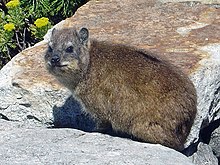
The hyraxes are any of four species of fairly small, thickset, herbivorous mammals in the order Hyracoidea. About the size of a domestic cat they are well furred, with rounded bodies and a stumpy tail. They are native to Africa and the Middle East.
- Family: Procaviidae (hyraxes)
- Genus: Heterohyrax
- Yellow-spotted rock hyrax, H. brucei LC
- Genus: Procavia
- Cape hyrax, P. capensis LC
- Genus: Heterohyrax
Order: Sirenia (manatees and dugongs)

Sirenia is an order of fully aquatic, herbivorous mammals that inhabit rivers, estuaries, coastal marine waters, swamps, and marine wetlands. All four species are endangered. These animals live in warm coastal waters from East Africa to Australia, including the Red Sea, Indian Ocean, and Pacific.
- Family: Dugongidae
- Genus: Dugong
- Dugong, D. dugon VU[2]
- Genus: Dugong
Order: Rodentia (rodents)


Rodents make up the largest order of mammals, with over 40% of mammalian species. They have two incisors in the upper and lower jaw which grow continually and must be kept short by gnawing. Most rodents are small though the capybara can weigh up to 45 kg (99 lb).
- Suborder: Hystricognathi
- Family: Hystricidae (Old World porcupines)
- Genus: Hystrix
- Crested porcupine, H. cristata LC possibly extirpated[3]
- Genus: Hystrix
- Family: Hystricidae (Old World porcupines)
- Suborder: Sciurognathi
- Family: Gliridae (dormice)
- Subfamily: Leithiinae
- Genus: Eliomys
- Asian garden dormouse, E. melanurus LC[4]
- Genus: Eliomys
- Subfamily: Leithiinae
- Family: Dipodidae (jerboas)
- Subfamily: Allactaginae
- Genus: Allactaga
- Four-toed jerboa, Allactaga tetradactyla DD
- Genus: Allactaga
- Subfamily: Dipodinae
- Genus: Jaculus
- Lesser Egyptian jerboa, Jaculus jaculus LC
- Greater Egyptian jerboa, Jaculus orientalis LC
- Genus: Jaculus
- Subfamily: Allactaginae
- Family: Spalacidae
- Subfamily: Spalacinae
- Genus: Nannospalax
- Middle East blind mole-rat, Nannospalax ehrenbergi LC
- Genus: Nannospalax
- Subfamily: Spalacinae
- Family: Muridae (mice, rats, voles, gerbils, hamsters, etc.)
- Subfamily: Deomyinae
- Genus: Acomys
- Cairo spiny mouse, Acomys cahirinus LC
- Golden spiny mouse, Acomys russatus LC
- Genus: Acomys
- Subfamily: Gerbillinae
- Genus: Dipodillus
- North African gerbil, Dipodillus campestris LC
- Mackilligin's gerbil, Dipodillus mackilligini LC
- Genus: Gerbillus
- Pleasant gerbil, Gerbillus amoenus DD
- Anderson's gerbil, Gerbillus andersoni LC
- Flower's gerbil, Gerbillus floweri LC
- Lesser Egyptian gerbil, Gerbillus gerbillus LC
- Pygmy gerbil, Gerbillus henleyi LC
- Balochistan gerbil, Gerbillus nanus LC
- Pale gerbil, Gerbillus perpallidus LC
- Greater Egyptian gerbil, Gerbillus pyramidum LC
- Lesser short-tailed gerbil, Gerbillus simoni LC
- Genus: Meriones
- Sundevall's jird, Meriones crassus LC
- Libyan jird, Meriones libycus LC
- Shaw's jird, Meriones shawi LC
- Genus: Pachyuromys
- Fat-tailed gerbil, Pachyuromys duprasi LC
- Genus: Psammomys
- Sand rat, Psammomys obesus LC
- Genus: Sekeetamys
- Bushy-tailed jird, Sekeetamys calurus LC
- Genus: Dipodillus
- Subfamily: Murinae
- Genus: Arvicanthis
- African grass rat, Arvicanthis niloticus LC
- Genus: Nesokia
- Short-tailed bandicoot rat, Nesokia indica LC
- Genus: Arvicanthis
- Subfamily: Deomyinae
- Family: Gliridae (dormice)
Order: Lagomorpha (lagomorphs)
The lagomorphs comprise two families, Leporidae (hares and rabbits), and Ochotonidae (pikas). Though they can resemble rodents, and were classified as a superfamily in that order until the early 20th century, they have since been considered a separate order. They differ from rodents in a number of physical characteristics, such as having four incisors in the upper jaw rather than two.
- Family: Leporidae (rabbits, hares)
- Genus: Lepus
- Cape hare, L. capensis LC[5]
- Genus: Lepus
Order: Erinaceomorpha (hedgehogs and gymnures)
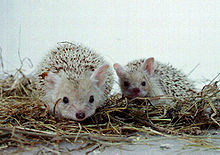
The order Erinaceomorpha contains a single family, Erinaceidae, which comprise the hedgehogs and gymnures. The hedgehogs are easily recognised by their spines while gymnures look more like large rats.
- Family: Erinaceidae (hedgehogs)
- Subfamily: Erinaceinae
- Genus: Hemiechinus
- Long-eared hedgehog, H. auritus LC
- Genus: Paraechinus
- Desert hedgehog, P. aethiopicus LC
- Genus: Hemiechinus
- Subfamily: Erinaceinae
Order: Soricomorpha (shrews, moles, and solenodons)
The "shrew-forms" are insectivorous mammals. Shrews and solenodons closely resemble mice, while moles are stout-bodied burrowers.
- Family: Soricidae (shrews)
Order: Chiroptera (bats)
The bats' most distinguishing feature is that their forelimbs are developed as wings, making them the only mammals capable of flight. Bat species account for about 20% of all mammals.
- Family: Pteropodidae (flying foxes, Old World fruit bats)
- Subfamily: Pteropodinae
- Genus: Rousettus
- Egyptian fruit bat, R. aegyptiacus LC[8]
- Genus: Rousettus
- Subfamily: Pteropodinae
- Family: Vespertilionidae
- Subfamily: Vespertilioninae
- Genus: Eptesicus
- Botta's serotine, Eptesicus bottae LC
- Genus: Hypsugo
- Desert pipistrelle, Hypsugo ariel DD
- Genus: Nycticeinops
- Schlieffen's bat, Nycticeinops schlieffeni LC
- Genus: Otonycteris
- Desert long-eared bat, Otonycteris hemprichii LC
- Genus: Pipistrellus
- Egyptian pipistrelle, Pipistrellus deserti LC
- Kuhl's pipistrelle, Pipistrellus kuhlii LC
- Rüppell's pipistrelle, Pipistrellus rueppelli LC
- Genus: Plecotus
- Christie's big-eared bat, Plecotus christiei DD
- Genus: Eptesicus
- Subfamily: Vespertilioninae
- Family: Rhinopomatidae
- Genus: Rhinopoma
- Egyptian mouse-tailed bat, R. cystops LC[9]
- Lesser mouse-tailed bat, Rhinopoma hardwickei LC
- Greater mouse-tailed bat, Rhinopoma microphyllum LC
- Genus: Rhinopoma
- Family: Molossidae
- Genus: Tadarida
- Egyptian free-tailed bat, Tadarida aegyptiaca LC
- European free-tailed bat, Tadarida teniotisLC
- Genus: Tadarida
- Family: Emballonuridae
- Genus: Taphozous
- Naked-rumped tomb bat, Taphozous nudiventris LC
- Egyptian tomb bat, Taphozous perforatus LC
- Genus: Taphozous
- Family: Nycteridae
- Genus: Nycteris
- Egyptian slit-faced bat, Nycteris thebaica LC
- Genus: Nycteris
- Family: Rhinolophidae
Order: Cetacea (whales and dolphins and porpoises)
The order Cetacea includes whales, dolphins and porpoises. They are the mammals most fully adapted to aquatic life with a spindle-shaped nearly hairless body, protected by a thick layer of blubber, and forelimbs and tail modified to provide propulsion underwater.
Species listed below also includes species being recorded in Levantine Sea.
- Suborder: Mysticeti
- Subfamily: Megapterinae
- Genus: Megaptera
- Humpback whale, Megaptera novaeangliae LC and CR (Arabian Sea population)[15]
- Genus: Megaptera
- Suborder: Odontoceti
- Family: Physeteridae
- Genus: Physeter
- Sperm whale, Physeter macrocephalus VU[16]
- Genus: Physeter
- Family: Ziphidae
- Genus: Ziphius
- Cuvier's beaked whale, Ziphius cavirostris LC
- Genus: Mesoplodon
- Gervais' beaked whale, Mesoplodon europaeus DD
- Genus: Ziphius
- Superfamily: Platanistoidea
- Family: Delphinidae (marine dolphins)
- Genus: Tursiops
- Common bottlenose dolphin, Tursiops truncatus LC
- Indo-Pacific bottlenose dolphin, Tursiops aduncus DD
- Genus: Steno
- Rough-toothed dolphin, Steno bredanensis DD (once being considered as vagrants, but later confirmed as residential[17])
- Genus: Stenella
- Striped dolphin, Stenella coeruleoalba DD
- Pantropical spotted dolphin, Stenella attenuata LC
- Spinner dolphin, Stenella longirostris LC
- Genus: Sousa
- Indo-Pacific humpback dolphin, Sousa chinensis DD
- Genus: Delphinus
- Short-beaked common dolphin, Delphinus delphis LC
- Indo-Pacific common dolphin, Delphinus tropicalis DD
- Genus: Grampus
- Risso's dolphin, Grampus griseus LC
- Genus: Orcinus
- Orca, O. orca DD[18]
- Genus: Pseudorca
- False killer whale, Pseudorca crassidens DD
- Genus: Globicephala
- Long-finned pilot whale, Globicephala melas DD
- Short-finned pilot whale, Globicephala macrorhynchus DD
- Genus: Tursiops
- Family: Delphinidae (marine dolphins)
- Family: Physeteridae
Order: Carnivora (carnivorans)
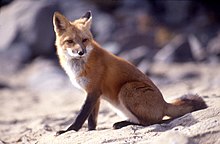

There are over 260 species of carnivorans, the majority of which eat meat as their primary dietary item. They have a characteristic skull shape and dentition.
- Suborder: Feliformia
- Family: Felidae (cats)
- Subfamily: Felinae
- Subfamily: Pantherinae
- Genus: Panthera
- Leopard, P. pardus VU[24]
- African leopard, P. p. pardus
- Leopard, P. pardus VU[24]
- Genus: Panthera
- Family: Viverridae (civets, mongooses, etc.)
- Subfamily: Viverrinae
- Genus: Genetta
- Common genet, G. genetta LC[25]
- Genus: Genetta
- Subfamily: Viverrinae
- Family: Herpestidae (mongooses)
- Family: Hyaenidae (hyaenas)
- Family: Felidae (cats)
- Suborder: Caniformia
- Family: Canidae (dogs, foxes)
- Family: Mustelidae (mustelids)
- Family: Phocidae (earless seals)
- Genus: Monachus
- Mediterranean monk seal, M. monachus EN possibly extirpated[39]
- Genus: Monachus
Order: Perissodactyla (odd-toed ungulates)
The odd-toed ungulates are browsing and grazing mammals. They are usually large to very large, and have relatively simple stomachs and a large middle toe.
- Family: Equidae (horses etc.)
- Genus: Equus
- African wild ass, E. africanus CR presence uncertain[40]
- Genus: Equus
Order: Artiodactyla (even-toed ungulates)
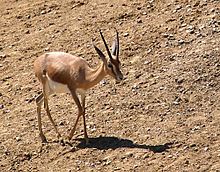
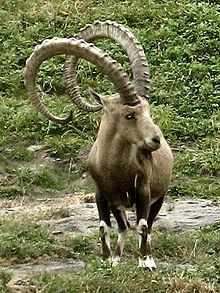
The even-toed ungulates are ungulates whose weight is borne about equally by the third and fourth toes, rather than mostly or entirely by the third as in perissodactyls. There are about 220 artiodactyl species, including many that are of great economic importance to humans.
- Family: Bovidae (cattle, antelope, sheep, goats)
- Genus: Gazella
- Subfamily: Caprinae
- Genus: Ammotragus
- Barbary sheep, A. lervia VU
- Genus: Capra
- Nubian ibex, C. nubiana VU[45]
- Genus: Ammotragus
Locally extinct
The following species are locally extinct in the country:
- Addax, Addax nasomaculatus[46]
- Hartebeest, Alcelaphus buselaphus[47]
- Hippopotamus, Hippopotamus amphibius[48]
- African bush elephant, Loxodonta africana[49]
- African wild dog, Lycaon pictus[50]
- Arabian oryx, Oryx leucoryx[51]
- Scimitar oryx, Oryx dammah[52]
- Lion, Panthera leo[53]
- Hamadryas baboon, Papio hamadryas[54]
- Wild boar, Sus scrofa[55]
- Brown bear, Ursus arctos[56]
See also
- Wildlife of Egypt
- Animal welfare in Egypt
- List of chordate orders
- Lists of mammals by region
- Mammal classification
References
- Taylor, A.; Lehmann, T. (2015). "Orycteropus afer". IUCN Red List of Threatened Species. 2015: e.T41504A21286437.
- Marsh, H. & Sobtzick, S. (2019). "Dugong dugon". IUCN Red List of Threatened Species. 2019: e.T6909A160756767.
- Amori, G. & De Smet, K. (2016). "Hystrix cristata". IUCN Red List of Threatened Species. 2016: e.T10746A22232484.
- Amori, G.; Aulagnier, S.; Hutterer, R.; Kryštufek, B.; Yigit, N.; Mitsain, G. & Palomo, L.J. (2016). "Eliomys melanurus". IUCN Red List of Threatened Species. 2016: e.T7619A115085446.
- Johnston, C.H.; Robinson, T.J.; Child, M.F. & Relton, C. (2019). "Lepus capensis". IUCN Red List of Threatened Species. 2019: e.T41277A45186750.
- Hutterer, R.; Amori, G.; Krystufek, B.; Yigit, N.; Mitsain, G. & Palomo, L.J. (2010). "Crocidura suaveolens". IUCN Red List of Threatened Species. 2010: e.T29656A9511068.
- Hutterer, R.; Molur, S. & Heaney, L. (2016). "Suncus murinus". IUCN Red List of Threatened Species. 2016: e.T41440A22287830.
- Korine, C. (2016). "Rousettus aegyptiacus". IUCN Red List of Threatened Species. 2016: e.T29730A22043105.
- Benda, P. (2017). "Rhinopoma cystops". IUCN Red List of Threatened Species. 2017: e.T82345555A82345569.
- Taylor, P. (2016). "Rhinolophus hipposideros". IUCN Red List of Threatened Species. 2016: e.T19518A21972794.
- Monadjem, A.; Bergmans, W.; Mickleburgh, S.; Kock, D.; Amr, Z.S.S. & Hutson, A.M. (2017). "Asellia tridens". IUCN Red List of Threatened Species. 2017: e.T80221529A21975715.
- Sciara di N.G., Smeenk C., Rudolph P., Addink M., Baldwin R., Cesario A., Costa M., Feingold D., Fumagalli M., Kerem D., Goffman O., Elasar M., Scheinin A., Hadar N.. 2014. Summary review of cetaceans of the Red Sea.
- https://www.cbd.int/doc/meetings/mar/ebsaws-2015-02/other/ebsaws-2015-02-gobi-submission9-en.pdf [bare URL PDF]
- Update on the Cetacean Fauna of the Mediterranean Levantine Basin
- Are humpback whales electing the Mediterranean Sea as new residence?
- "Whale spotted off Larnaca". Archived from the original on 2016-04-24. Retrieved 2016-04-19.
- "Archived copy" (PDF). Archived from the original (PDF) on 2016-05-13. Retrieved 2016-04-19.
{{cite web}}: CS1 maint: archived copy as title (link) - Reeves, R.; Pitman, R.L. & Ford, J.K.B. (2017). "Orcinus orca". IUCN Red List of Threatened Species. 2017: e.T15421A50368125.
- Durant, S.; Mitchell, N.; Ipavec, A. & Groom, R. (2015). "Acinonyx jubatus". IUCN Red List of Threatened Species. 2015: e.T219A50649567.
- Avgan, B.; Henschel, P. & Ghoddousi, A. (2016). "Caracal caracal". IUCN Red List of Threatened Species. 2016: e.T3847A102424310.
- Gray, T.N.E.; Timmins, R.J.; Jathana, D.; Duckworth, J.W.; Baral, H. & Mukherjee, S. (2016). "Felis chaus". IUCN Red List of Threatened Species. 2016: e.T8540A50651463.
- Ghoddousi, A.; Belbachir, F.; Durant, S.M.; Herbst, M. & Rosen, T. (2022). "Felis lybica". IUCN Red List of Threatened Species. 2022: e.T131299383A154907281. doi:10.2305/IUCN.UK.2022-1.RLTS.T131299383A154907281.en.
- Sliwa, A.; Ghadirian, T.; Appel, A.; Banfield, L.; Sher Shah, M. & Wacher, T. (2016). "Felis margarita". IUCN Red List of Threatened Species. 2016: e.T8541A50651884.
- Stein, A. B.; Athreya, V.; Gerngross, P.; Balme, G.; Henschel, P.; Karanth, U.; Miquelle, D.; Rostro, S.; Kamler, J.F. & Laguardia, A. (2016). "Panthera pardus". IUCN Red List of Threatened Species. 2016: e.T15954A160698029.
- Gaubert, P.; Carvalho, F.; Camps, D. & Do Linh San, E. (2015). "Genetta genetta". IUCN Red List of Threatened Species. 2015: e.T41698A45218636.
- Do Linh San, E.; Maddock, A. H. & Gaubert, P. & Palomares, F. (2016). "Herpestes ichneumon". IUCN Red List of Threatened Species. 2016: e.T41613A45207211.
{{cite journal}}: CS1 maint: multiple names: authors list (link) - Do Linh San, E. (2015). "Ichneumia albicauda". IUCN Red List of Threatened Species. 2015: e.T41620A45208640. Retrieved 12 October 2020.
- AbiSaid, M. & Dloniak, S.M.D. (2015). "Hyaena hyaena". IUCN Red List of Threatened Species. 2015: e.T10274A45195080.
- Green, D.S. (2015). "Proteles cristata". IUCN Red List of Threatened Species. 2015: e.T18372A45195681.
- Hoffmann, M. & Atickem, A. (2019). "Canis lupaster". IUCN Red List of Threatened Species. 2019: e.T118264888A118265889.
- Boitani, L.; Phillips, M. & Jhala, Y. (2018). "Canis lupus". IUCN Red List of Threatened Species. 2018: e.T3746A119623865.
- Hoffmann, M. & Sillero-Zubiri, C. (2015). "Vulpes cana". IUCN Red List of Threatened Species. 2015: e.T23050A48075169.
- Mallon, D.; Murdoch, J.D. & Wacher, T. (2015). "Vulpes rueppelli". IUCN Red List of Threatened Species. 2015: e.T23053A46197483.
- Hoffmann, M. & Sillero-Zubiri, C. (2016). "Vulpes vulpes". IUCN Red List of Threatened Species. 2016: e.T23062A46190249.
- Wacher, T.; Bauman, K. & Cuzin, F. (2015). "Vulpes zerda". IUCN Red List of Threatened Species. 2015: e.T41588A46173447.
- Ahmim, M. & Do Linh San, E. (2015). "Ictonyx libyca". IUCN Red List of Threatened Species. 2015: e.T41645A45212347.
- McDonald, R. A.; Abramov, A. V.; Stubbe, M.; Herrero, J.; Maran, T.; Tikhonov, A.; Cavallini, P.; Kranz, A.; Giannatos, G.; Kryštufek, B. & Reid, F. (2019). "Mustela nivalis". IUCN Red List of Threatened Species. 2019: e.T70207409A147993366.
- McDonald, R. & Hoffmann, M. (2016). "Mustela subpalmata". IUCN Red List of Threatened Species. 2016: e.T41660A65993325.
- Karamanlidis, A. & Dendrinos, P. (2015). "Monachus monachus". IUCN Red List of Threatened Species. 2015: e.T13653A45227543.
- Moehlman, P.D.; Kebede, F. & Yohannes, H. (2015). "Equus africanus". IUCN Red List of Threatened Species. 2015: e.T7949A45170994.
- IUCN SSC Antelope Specialist Group (2017). "Gazella arabica". IUCN Red List of Threatened Species. 2017: e.T117582065A88018124. doi:10.2305/IUCN.UK.2017-2.RLTS.T117582065A88018124.en.
- IUCN SSC Antelope Specialist Group (2017). "Gazella dorcas". IUCN Red List of Threatened Species. 2017: e.T8969A50186334.
- IUCN SSC Antelope Specialist Group (2017). "Gazella gazella". IUCN Red List of Threatened Species. 2017: e.T8989A50186574.
- IUCN SSC Antelope Specialist Group (2016). "Gazella leptoceros". IUCN Red List of Threatened Species. 2016: e.T8972A50186909.
- Ross, S.; Elalqamy, H.; Al Said, T. & Saltz, D. (2020). "Capra nubiana". IUCN Red List of Threatened Species. 2020: e.T3796A22143385.
- IUCN SSC Antelope Specialist Group (2016). "Addax nasomaculatus". IUCN Red List of Threatened Species. 2016: e.T512A50180603.
- IUCN SSC Antelope Specialist Group (2019) [amended version of 2016 assessment]. "Alcelaphus buselaphus". IUCN Red List of Threatened Species. 2019: e.T811A143160967.
- Lewison, R. & Pluháček, J. (2017). "Hippopotamus amphibius". IUCN Red List of Threatened Species. 2017: e.T10103A18567364.
- Gannon, Megan (8 September 2014). "Climate and Civilization Killed Egypt's Animals". livescience.com. Retrieved 8 September 2014.
- Woodroffe, R. & Sillero-Zubiri, C. (2020). "Lycaon pictus". IUCN Red List of Threatened Species. 2020: e.T12436A166502262.
- IUCN SSC Antelope Specialist Group (2017). "Oryx leucoryx". IUCN Red List of Threatened Species. 2017: e.T15569A50191626.
- IUCN SSC Antelope Specialist Group (2016). "Oryx dammah". IUCN Red List of Threatened Species. 2016: e.T15568A50191470.
- Bauer, H.; Packer, C.; Funston, P. F.; Henschel, P. & Nowell, K. (2017) [errata version of 2016 assessment]. "Panthera leo". IUCN Red List of Threatened Species. 2016: e.T15951A115130419.
- Gippoliti, S. (2019). "Papio hamadryas". IUCN Red List of Threatened Species. 2019: e.T16019A17953082.
- Keuling, O. & Leus, K. (2019). "Sus scrofa". IUCN Red List of Threatened Species. 2019: e.T41775A44141833.
- McLellan, B.N.; Proctor, M.F.; Huber, D. & Michel, S. (2017). "Ursus arctos". IUCN Red List of Threatened Species. 2017: e.T41688A121229971.
External links
- "Animal Diversity Web". University of Michigan Museum of Zoology. 1995–2006. Retrieved 22 May 2007.
Другой контент может иметь иную лицензию. Перед использованием материалов сайта WikiSort.org внимательно изучите правила лицензирования конкретных элементов наполнения сайта.
WikiSort.org - проект по пересортировке и дополнению контента Википедии